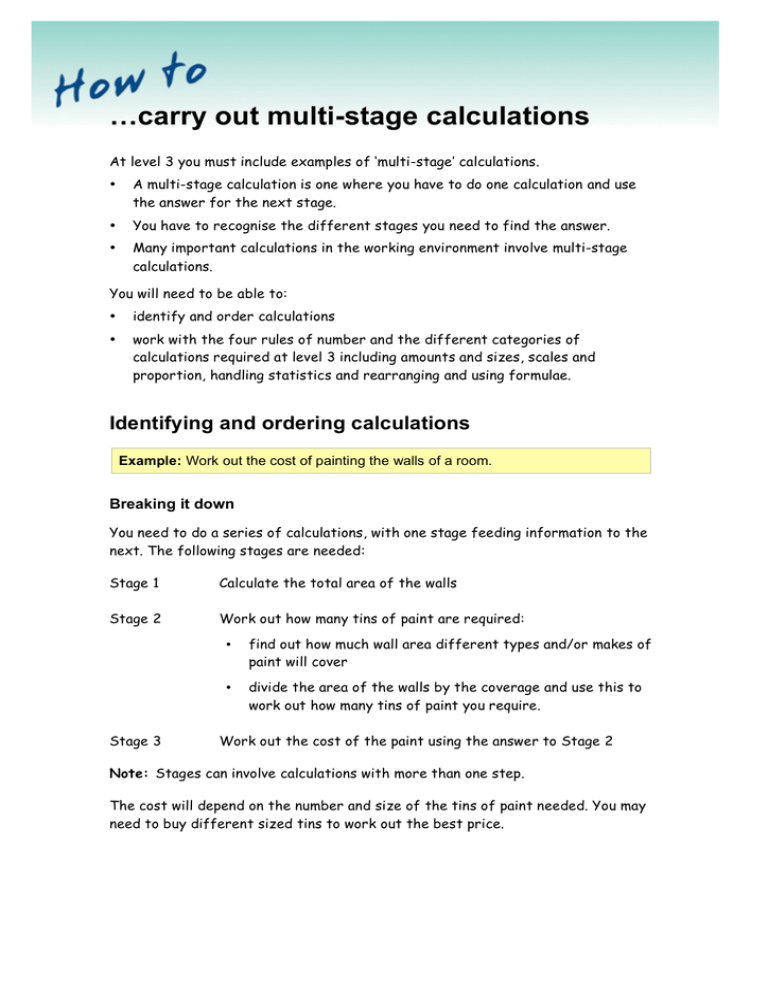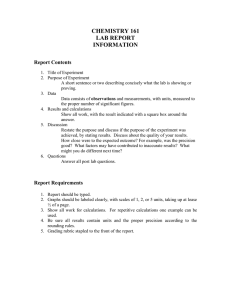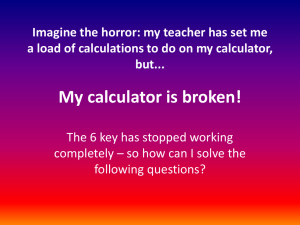…carry out multi-stage calculations
advertisement

…carry out multi-stage calculations At level 3 you must include examples of ‘multi-stage’ calculations. • A multi-stage calculation is one where you have to do one calculation and use the answer for the next stage. • You have to recognise the different stages you need to find the answer. • Many important calculations in the working environment involve multi-stage calculations. You will need to be able to: • identify and order calculations • work with the four rules of number and the different categories of calculations required at level 3 including amounts and sizes, scales and proportion, handling statistics and rearranging and using formulae. Identifying and ordering calculations Example: Work out the cost of painting the walls of a room. Breaking it down You need to do a series of calculations, with one stage feeding information to the next. The following stages are needed: Stage 1 Calculate the total area of the walls Stage 2 Work out how many tins of paint are required: • • Stage 3 find out how much wall area different types and/or makes of paint will cover divide the area of the walls by the coverage and use this to work out how many tins of paint you require. Work out the cost of the paint using the answer to Stage 2 Note: Stages can involve calculations with more than one step. The cost will depend on the number and size of the tins of paint needed. You may need to buy different sized tins to work out the best price. Worked example 1 A swimming pool is 15 m long by 8 m wide and has an average depth of 1.5 m. A chemical needs to be added in a concentration of 5 millilitres for each 100 litres. The chemical costs £5.00 per litre. How much does it cost for the chemical? Hint: 1 litre = 1 000 millilitres; 1 cubic metre holds 1 000 litres. Stage 1 Find the capacity of the pool: The volume of the pool is 15 x 8 x 1.5 = 180 cubic metres 180 cubic metres = 180 000 litres Stage 2 Work out the amount of chemical required: 180 000 ÷ 100 = 1800 so we need to add 1 800 x 5 millilitres 1 800 x 5 = 9 000 ml or 9 litres Stage 3 Calculate the cost of the chemical: 9 litres at £5.00 per litre is £45.00 in total Answer: The chemical would cost £45.00. Worked example 2 Cheryl started work at an annual salary of £12 000. In the first year of her employment, the inflation rate was 3%; in the second and third years, the inflation rate was 3.5% and 2.5%. How much should she be earning at the start of the fourth year to have kept up with inflation? Stage 1 Find her starting salary for Year 2: 3% of £12 000 = £360 £12 000 + £360 = £12 360 Stage 2 Find the starting salary for Year 3: 3.5% of £12 360 = £432.60 £12 360 + £432.60 = £12 792.60 Stage 3 Find the starting salary for Year 4: 2.5% of £12 792.60 = £319.82 (rounded up) £12 792.60 + £319.82 = £13 112.42 Answer: To have kept up with inflation, Cheryl needs to be earning £13 112.42 at the start of the fourth year. Note: You can use the following calculation to check your answer: 12 000 x 1.03 x 1.035 x 1.025 = 13 112.42 (rounded up) Common errors include not demonstrating examples of multi-stage calculations in the portfolio and not being able to recognise the correct calculations or order of the calculations needed to find the answer. Opportunities for practice A photocopier is bought for £2 000 and loses 20% of its value each year. What would it be worth after 3 years?



